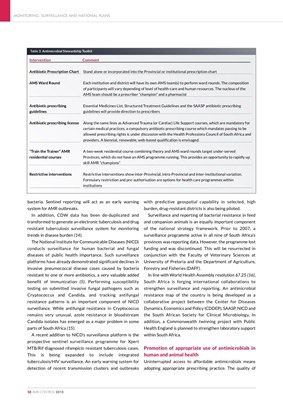
bacteria. Sentinel reporting will act as an early warning
system for AMR outbreaks.
In addition, CDW data has been de-duplicated and
transformed to generate an electronic tuberculosis and drug
resistant tuberculosis surveillance system for monitoring
trends in disease burden (14).
The National Institute for Communicable Diseases (NICD)
conducts surveillance for human bacterial and fungal
diseases of public health importance. Such surveillance
platforms have already demonstrated significant declines in
invasive pneumococcal disease cases caused by bacteria
resistant to one or more antibiotics, a very valuable added
benefit of immunization (5). Performing susceptibility
testing on submitted invasive fungal pathogens such as
Cryptococcus and Candida, and tracking antifungal
resistance patterns is an important component of NICD
surveillance. While antifungal resistance in Cryptococcus
remains very unusual, azole resistance in bloodstream
Candida isolates has emerged as a major problem in some
parts of South Africa (15).
A recent addition to NICD's surveillance platform is the
prospective sentinel surveillance programme for Xpert
MTB/Rif diagnosed rifampicin resistant tuberculosis cases.
This is being expanded to include integrated
tuberculosis/HIV surveillance. An early warning system for
detection of recent transmission clusters and outbreaks
with predictive geospatial capability in selected, high
burden, drug-resistant districts is also being piloted.
Surveillance and reporting of bacterial resistance in feed
and companion animals is an equally important component
of the national strategy framework. Prior to 2007, a
surveillance programme active in all nine of South Africa's
provinces was reporting data. However, the programme lost
funding and was discontinued. This will be resurrected in
conjunction with the Faculty of Veterinary Sciences at
University of Pretoria and the Department of Agriculture,
Forestry and Fisheries (DAFF).
In line with World Health Assembly resolution 67.25 (16),
South Africa is forging international collaborations to
strengthen surveillance and reporting. An antimicrobial
resistance map of the country is being developed as a
collaborative project between the Center for Diseases
Dynamics, Economics and Policy (CDDEP), SAASP, NICD and
the South African Society for Clinical Microbiology. In
addition, a Commonwealth twinning project with Public
Health England is planned to strengthen laboratory support
within South Africa.
Promotion of appropriate use of antimicrobials in
human and animal health
Uninterrupted access to affordable antimicrobials means
adopting appropriate prescribing practice. The quality of
MONITORING, SURVEILLANCE AND NATIONAL PLANS
58 AMR CONTROL 2015
Table 3: Antimicrobial Stewardship Toolkit
Antibiotic Prescription Chart
AMS Ward Round
Antibiotic prescribing
guidelines
Antibiotic prescribing license
"Train the Trainer" AMR
residential courses
Restrictive interventions
Stand alone or incorporated into the Provincial or institutional prescription chart
Each institution and district will have its own AMS team(s) to perform ward rounds. The composition
of participants will vary depending of level of health-care and human resources. The nucleus of the
AMS team should be a prescriber "champion" and a pharmacist
Essential Medicines List, Structured Treatment Guidelines and the SAASP antibiotic prescribing
guidelines will provide direction to prescribers
Along the same lines as Advanced Trauma (or Cardiac) Life Support courses, which are mandatory for
certain medical practices, a compulsory antibiotic prescribing course which mandates passing to be
allowed prescribing rights is under discussion with the Health Professions Council of South Africa and
providers. A biennial, renewable, web-based qualification is envisaged.
A two-week residential course combining theory and AMS ward rounds target under-served
Provinces, which do not have an AMS programme running. This provides an opportunity to rapidly up
skill AMR "champions"
Restrictive interventions show inter-Provincial, intra-Provincial and inter-institutional variation.
Formulary restriction and pre-authorisation are options for health care programmes within
institutions
Intervention Comment